Economics 101: Applying Economic Principles to Market Scenarios
VerifiedAdded on 2023/01/05
|10
|1500
|99
Homework Assignment
AI Summary
This economics assignment delves into several core economic principles. It begins by defining opportunity cost and applying it to real-world scenarios like college enrollment versus employment. The assignment then analyzes supply and demand dynamics, including shifts in demand curves due to changes in consumer income and the impact of government policies. It examines how changes in supply, such as improved cattle feed, affect market equilibrium. Furthermore, the assignment explores the concept of inelastic demand using the example of heroin and its implications on revenue and also examines the effects of fixed prices during festive seasons. Finally, it discusses the characteristics of public goods, illustrating them with examples like street lighting and public parks. The student demonstrates an understanding of economic models and their application to market analysis and public policy.
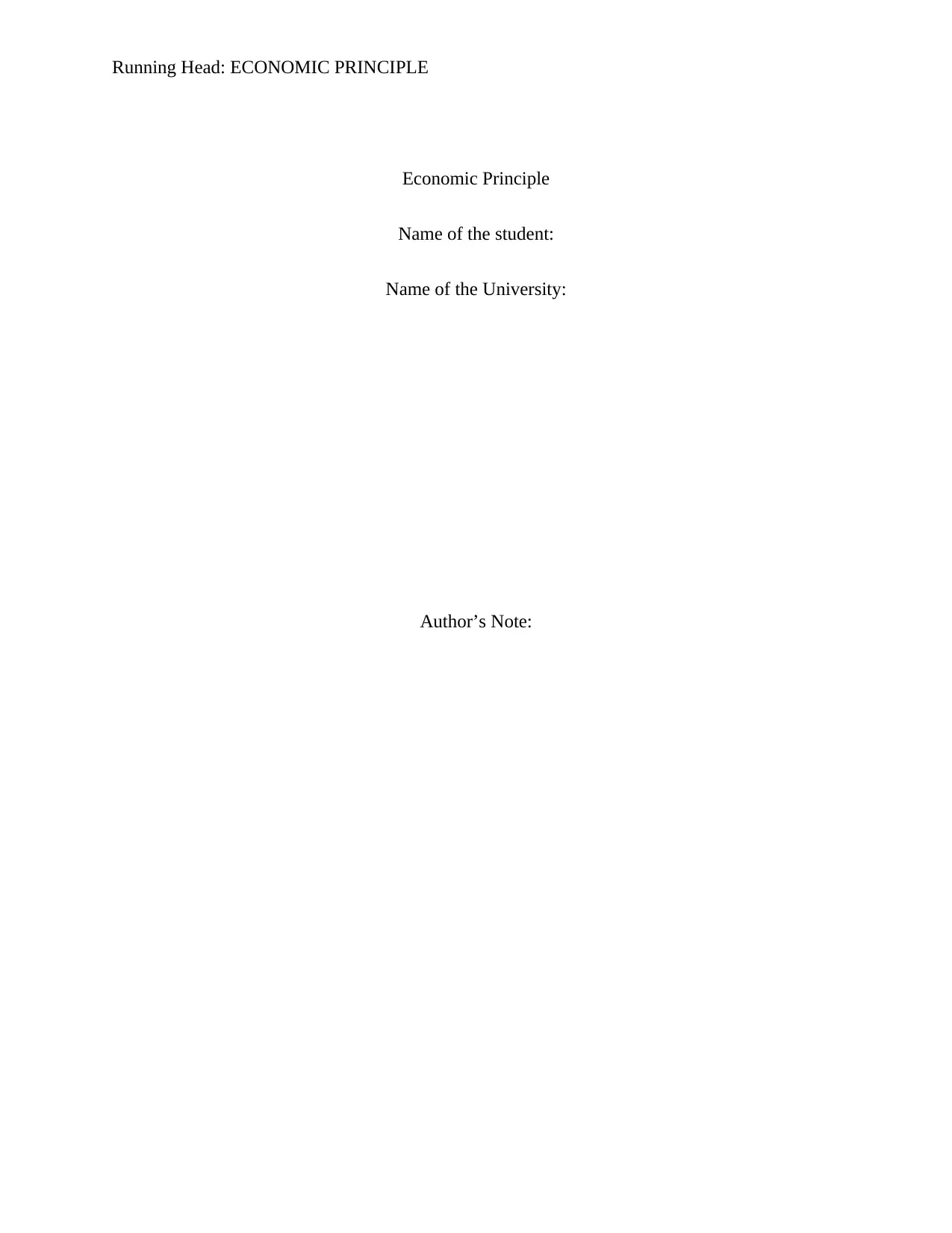
Running Head: ECONOMIC PRINCIPLE
Economic Principle
Name of the student:
Name of the University:
Author’s Note:
Economic Principle
Name of the student:
Name of the University:
Author’s Note:
Paraphrase This Document
Need a fresh take? Get an instant paraphrase of this document with our AI Paraphraser
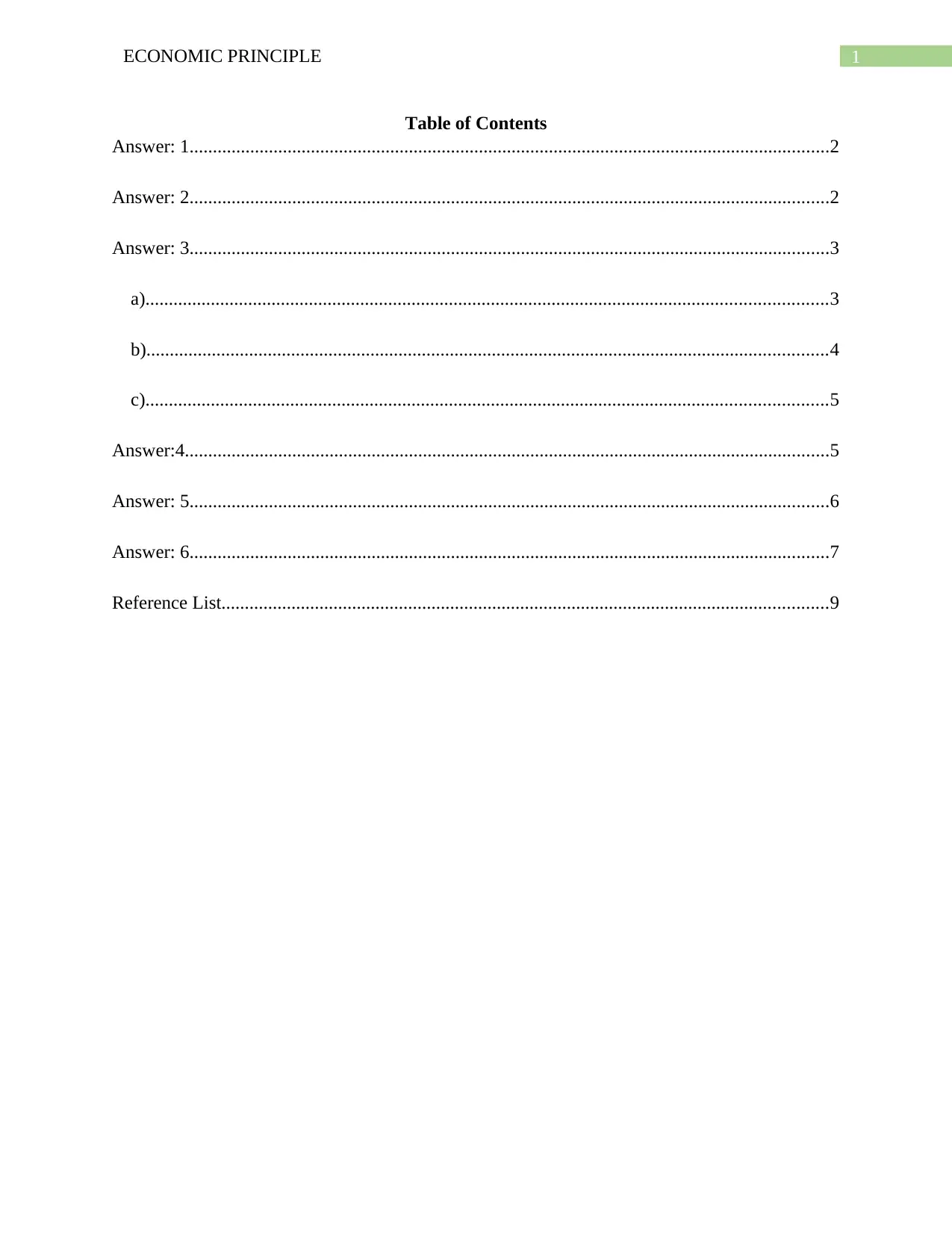
1ECONOMIC PRINCIPLE
Table of Contents
Answer: 1.........................................................................................................................................2
Answer: 2.........................................................................................................................................2
Answer: 3.........................................................................................................................................3
a)..................................................................................................................................................3
b)..................................................................................................................................................4
c)..................................................................................................................................................5
Answer:4..........................................................................................................................................5
Answer: 5.........................................................................................................................................6
Answer: 6.........................................................................................................................................7
Reference List..................................................................................................................................9
Table of Contents
Answer: 1.........................................................................................................................................2
Answer: 2.........................................................................................................................................2
Answer: 3.........................................................................................................................................3
a)..................................................................................................................................................3
b)..................................................................................................................................................4
c)..................................................................................................................................................5
Answer:4..........................................................................................................................................5
Answer: 5.........................................................................................................................................6
Answer: 6.........................................................................................................................................7
Reference List..................................................................................................................................9
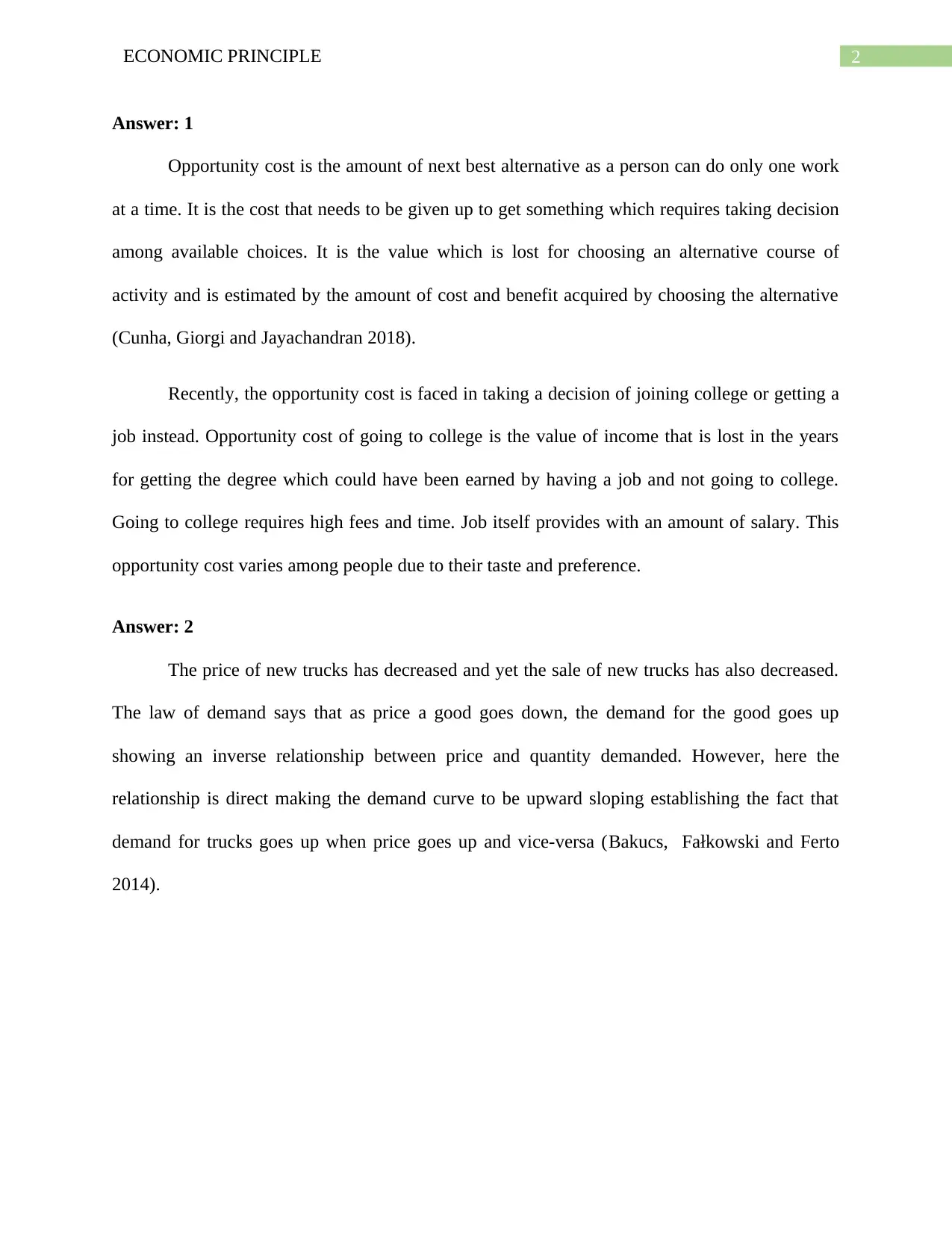
2ECONOMIC PRINCIPLE
Answer: 1
Opportunity cost is the amount of next best alternative as a person can do only one work
at a time. It is the cost that needs to be given up to get something which requires taking decision
among available choices. It is the value which is lost for choosing an alternative course of
activity and is estimated by the amount of cost and benefit acquired by choosing the alternative
(Cunha, Giorgi and Jayachandran 2018).
Recently, the opportunity cost is faced in taking a decision of joining college or getting a
job instead. Opportunity cost of going to college is the value of income that is lost in the years
for getting the degree which could have been earned by having a job and not going to college.
Going to college requires high fees and time. Job itself provides with an amount of salary. This
opportunity cost varies among people due to their taste and preference.
Answer: 2
The price of new trucks has decreased and yet the sale of new trucks has also decreased.
The law of demand says that as price a good goes down, the demand for the good goes up
showing an inverse relationship between price and quantity demanded. However, here the
relationship is direct making the demand curve to be upward sloping establishing the fact that
demand for trucks goes up when price goes up and vice-versa (Bakucs, Fałkowski and Ferto
2014).
Answer: 1
Opportunity cost is the amount of next best alternative as a person can do only one work
at a time. It is the cost that needs to be given up to get something which requires taking decision
among available choices. It is the value which is lost for choosing an alternative course of
activity and is estimated by the amount of cost and benefit acquired by choosing the alternative
(Cunha, Giorgi and Jayachandran 2018).
Recently, the opportunity cost is faced in taking a decision of joining college or getting a
job instead. Opportunity cost of going to college is the value of income that is lost in the years
for getting the degree which could have been earned by having a job and not going to college.
Going to college requires high fees and time. Job itself provides with an amount of salary. This
opportunity cost varies among people due to their taste and preference.
Answer: 2
The price of new trucks has decreased and yet the sale of new trucks has also decreased.
The law of demand says that as price a good goes down, the demand for the good goes up
showing an inverse relationship between price and quantity demanded. However, here the
relationship is direct making the demand curve to be upward sloping establishing the fact that
demand for trucks goes up when price goes up and vice-versa (Bakucs, Fałkowski and Ferto
2014).
⊘ This is a preview!⊘
Do you want full access?
Subscribe today to unlock all pages.

Trusted by 1+ million students worldwide
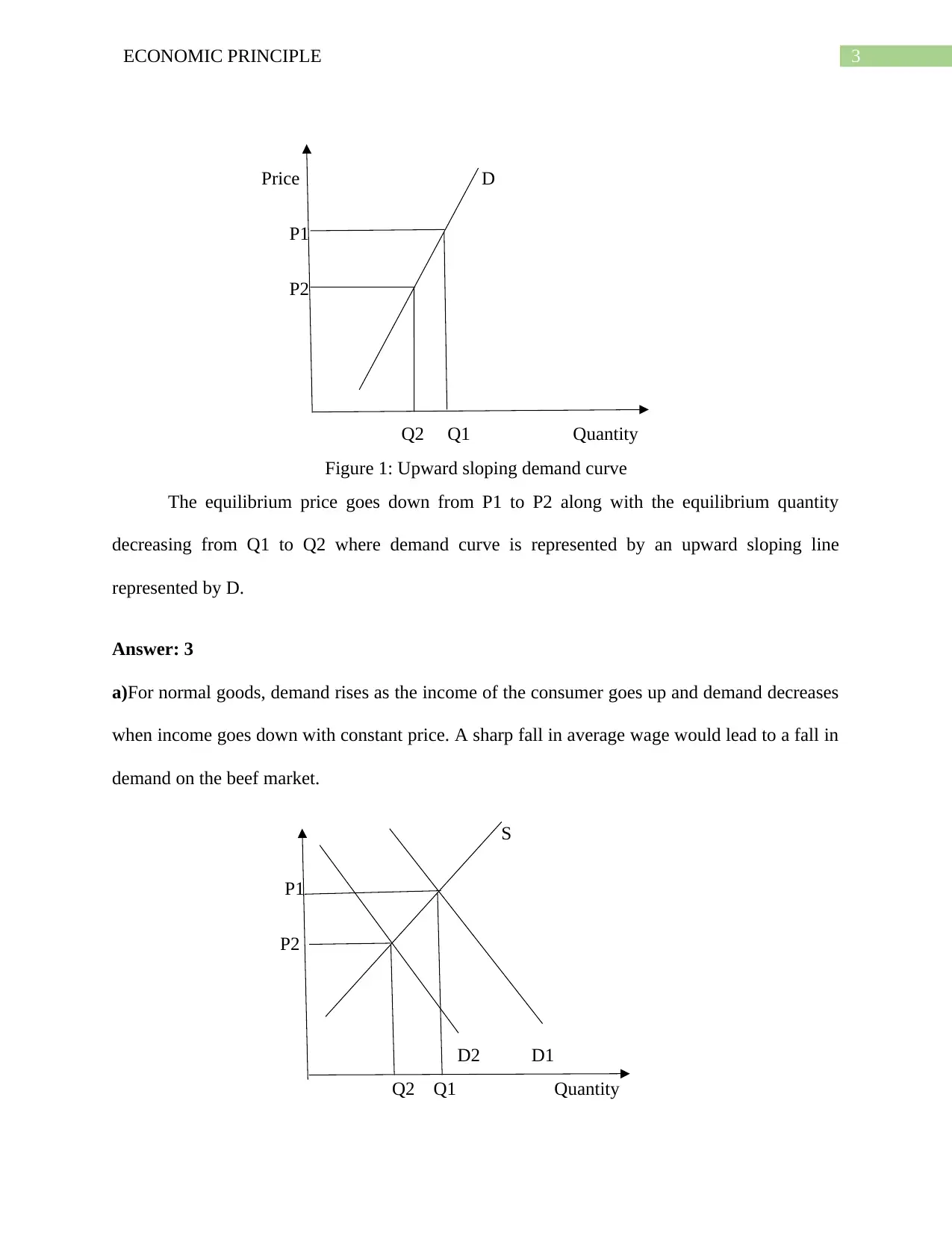
3ECONOMIC PRINCIPLE
Price D
P1
P2
Q2 Q1 Quantity
Figure 1: Upward sloping demand curve
The equilibrium price goes down from P1 to P2 along with the equilibrium quantity
decreasing from Q1 to Q2 where demand curve is represented by an upward sloping line
represented by D.
Answer: 3
a)For normal goods, demand rises as the income of the consumer goes up and demand decreases
when income goes down with constant price. A sharp fall in average wage would lead to a fall in
demand on the beef market.
S
P1
P2
D2 D1
Q2 Q1 Quantity
Price D
P1
P2
Q2 Q1 Quantity
Figure 1: Upward sloping demand curve
The equilibrium price goes down from P1 to P2 along with the equilibrium quantity
decreasing from Q1 to Q2 where demand curve is represented by an upward sloping line
represented by D.
Answer: 3
a)For normal goods, demand rises as the income of the consumer goes up and demand decreases
when income goes down with constant price. A sharp fall in average wage would lead to a fall in
demand on the beef market.
S
P1
P2
D2 D1
Q2 Q1 Quantity
Paraphrase This Document
Need a fresh take? Get an instant paraphrase of this document with our AI Paraphraser
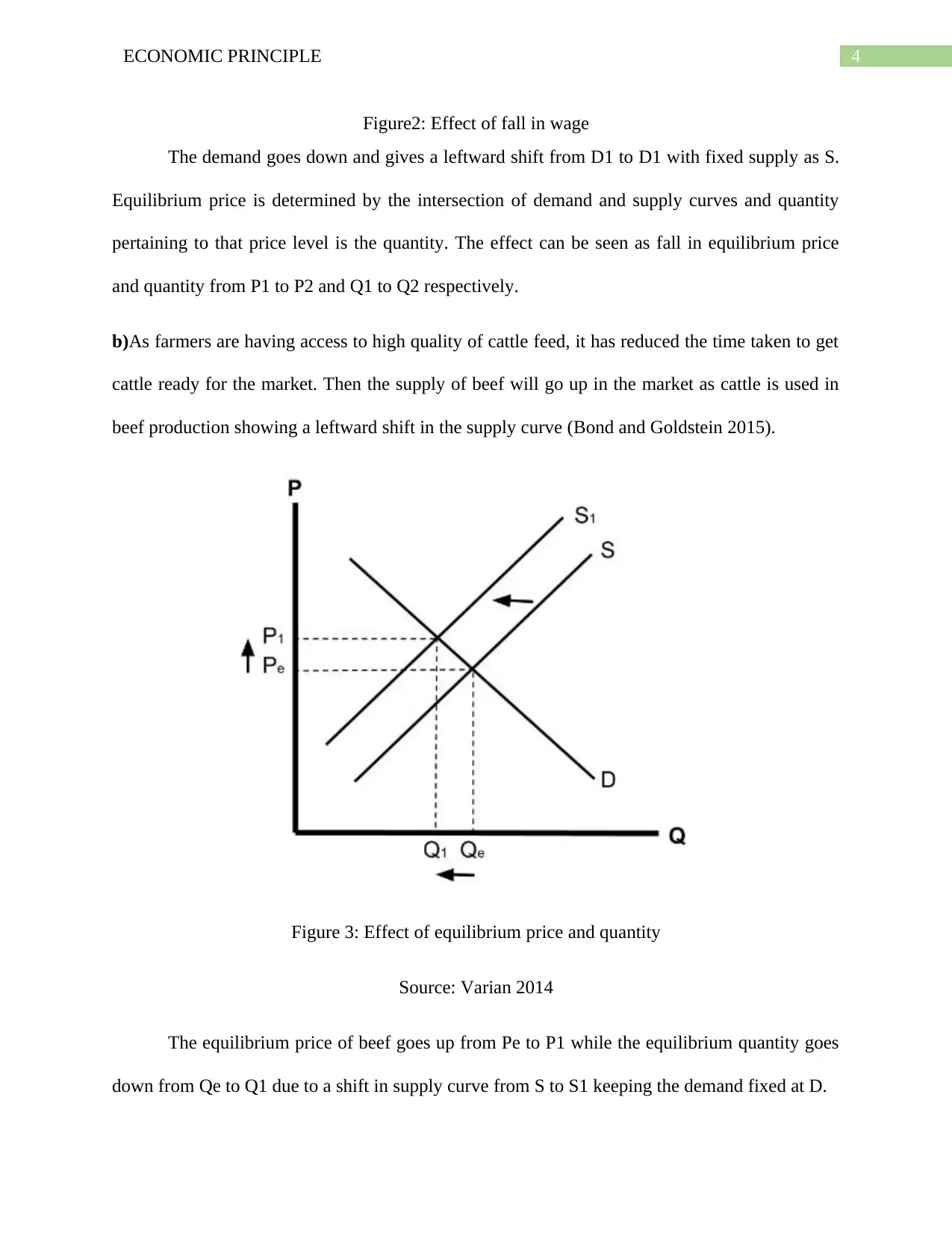
4ECONOMIC PRINCIPLE
Figure2: Effect of fall in wage
The demand goes down and gives a leftward shift from D1 to D1 with fixed supply as S.
Equilibrium price is determined by the intersection of demand and supply curves and quantity
pertaining to that price level is the quantity. The effect can be seen as fall in equilibrium price
and quantity from P1 to P2 and Q1 to Q2 respectively.
b)As farmers are having access to high quality of cattle feed, it has reduced the time taken to get
cattle ready for the market. Then the supply of beef will go up in the market as cattle is used in
beef production showing a leftward shift in the supply curve (Bond and Goldstein 2015).
Figure 3: Effect of equilibrium price and quantity
Source: Varian 2014
The equilibrium price of beef goes up from Pe to P1 while the equilibrium quantity goes
down from Qe to Q1 due to a shift in supply curve from S to S1 keeping the demand fixed at D.
Figure2: Effect of fall in wage
The demand goes down and gives a leftward shift from D1 to D1 with fixed supply as S.
Equilibrium price is determined by the intersection of demand and supply curves and quantity
pertaining to that price level is the quantity. The effect can be seen as fall in equilibrium price
and quantity from P1 to P2 and Q1 to Q2 respectively.
b)As farmers are having access to high quality of cattle feed, it has reduced the time taken to get
cattle ready for the market. Then the supply of beef will go up in the market as cattle is used in
beef production showing a leftward shift in the supply curve (Bond and Goldstein 2015).
Figure 3: Effect of equilibrium price and quantity
Source: Varian 2014
The equilibrium price of beef goes up from Pe to P1 while the equilibrium quantity goes
down from Qe to Q1 due to a shift in supply curve from S to S1 keeping the demand fixed at D.
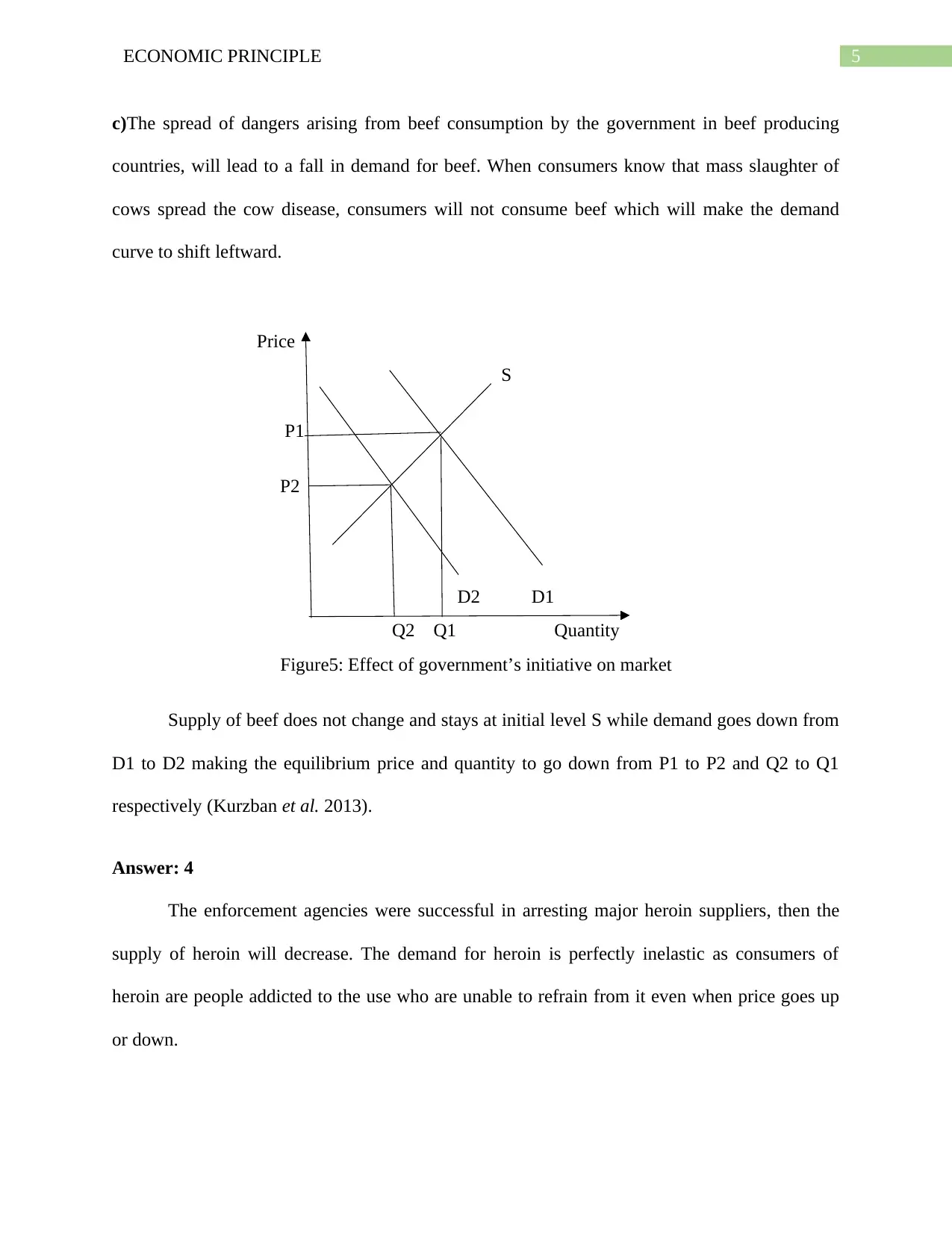
5ECONOMIC PRINCIPLE
c)The spread of dangers arising from beef consumption by the government in beef producing
countries, will lead to a fall in demand for beef. When consumers know that mass slaughter of
cows spread the cow disease, consumers will not consume beef which will make the demand
curve to shift leftward.
Price
S
P1
P2
D2 D1
Q2 Q1 Quantity
Figure5: Effect of government’s initiative on market
Supply of beef does not change and stays at initial level S while demand goes down from
D1 to D2 making the equilibrium price and quantity to go down from P1 to P2 and Q2 to Q1
respectively (Kurzban et al. 2013).
Answer: 4
The enforcement agencies were successful in arresting major heroin suppliers, then the
supply of heroin will decrease. The demand for heroin is perfectly inelastic as consumers of
heroin are people addicted to the use who are unable to refrain from it even when price goes up
or down.
c)The spread of dangers arising from beef consumption by the government in beef producing
countries, will lead to a fall in demand for beef. When consumers know that mass slaughter of
cows spread the cow disease, consumers will not consume beef which will make the demand
curve to shift leftward.
Price
S
P1
P2
D2 D1
Q2 Q1 Quantity
Figure5: Effect of government’s initiative on market
Supply of beef does not change and stays at initial level S while demand goes down from
D1 to D2 making the equilibrium price and quantity to go down from P1 to P2 and Q2 to Q1
respectively (Kurzban et al. 2013).
Answer: 4
The enforcement agencies were successful in arresting major heroin suppliers, then the
supply of heroin will decrease. The demand for heroin is perfectly inelastic as consumers of
heroin are people addicted to the use who are unable to refrain from it even when price goes up
or down.
⊘ This is a preview!⊘
Do you want full access?
Subscribe today to unlock all pages.

Trusted by 1+ million students worldwide
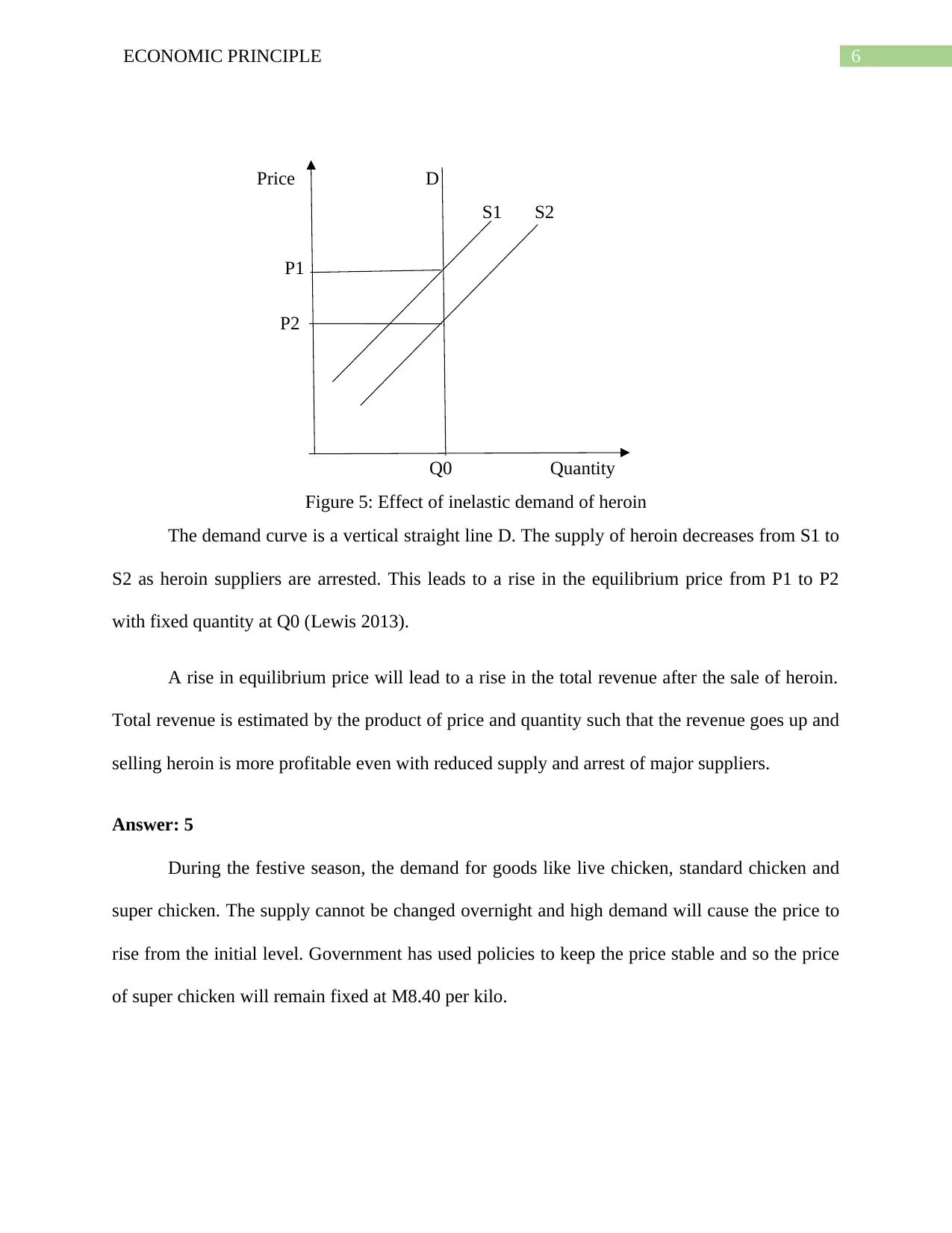
6ECONOMIC PRINCIPLE
Price D
S1 S2
P1
P2
Q0 Quantity
Figure 5: Effect of inelastic demand of heroin
The demand curve is a vertical straight line D. The supply of heroin decreases from S1 to
S2 as heroin suppliers are arrested. This leads to a rise in the equilibrium price from P1 to P2
with fixed quantity at Q0 (Lewis 2013).
A rise in equilibrium price will lead to a rise in the total revenue after the sale of heroin.
Total revenue is estimated by the product of price and quantity such that the revenue goes up and
selling heroin is more profitable even with reduced supply and arrest of major suppliers.
Answer: 5
During the festive season, the demand for goods like live chicken, standard chicken and
super chicken. The supply cannot be changed overnight and high demand will cause the price to
rise from the initial level. Government has used policies to keep the price stable and so the price
of super chicken will remain fixed at M8.40 per kilo.
Price D
S1 S2
P1
P2
Q0 Quantity
Figure 5: Effect of inelastic demand of heroin
The demand curve is a vertical straight line D. The supply of heroin decreases from S1 to
S2 as heroin suppliers are arrested. This leads to a rise in the equilibrium price from P1 to P2
with fixed quantity at Q0 (Lewis 2013).
A rise in equilibrium price will lead to a rise in the total revenue after the sale of heroin.
Total revenue is estimated by the product of price and quantity such that the revenue goes up and
selling heroin is more profitable even with reduced supply and arrest of major suppliers.
Answer: 5
During the festive season, the demand for goods like live chicken, standard chicken and
super chicken. The supply cannot be changed overnight and high demand will cause the price to
rise from the initial level. Government has used policies to keep the price stable and so the price
of super chicken will remain fixed at M8.40 per kilo.
Paraphrase This Document
Need a fresh take? Get an instant paraphrase of this document with our AI Paraphraser
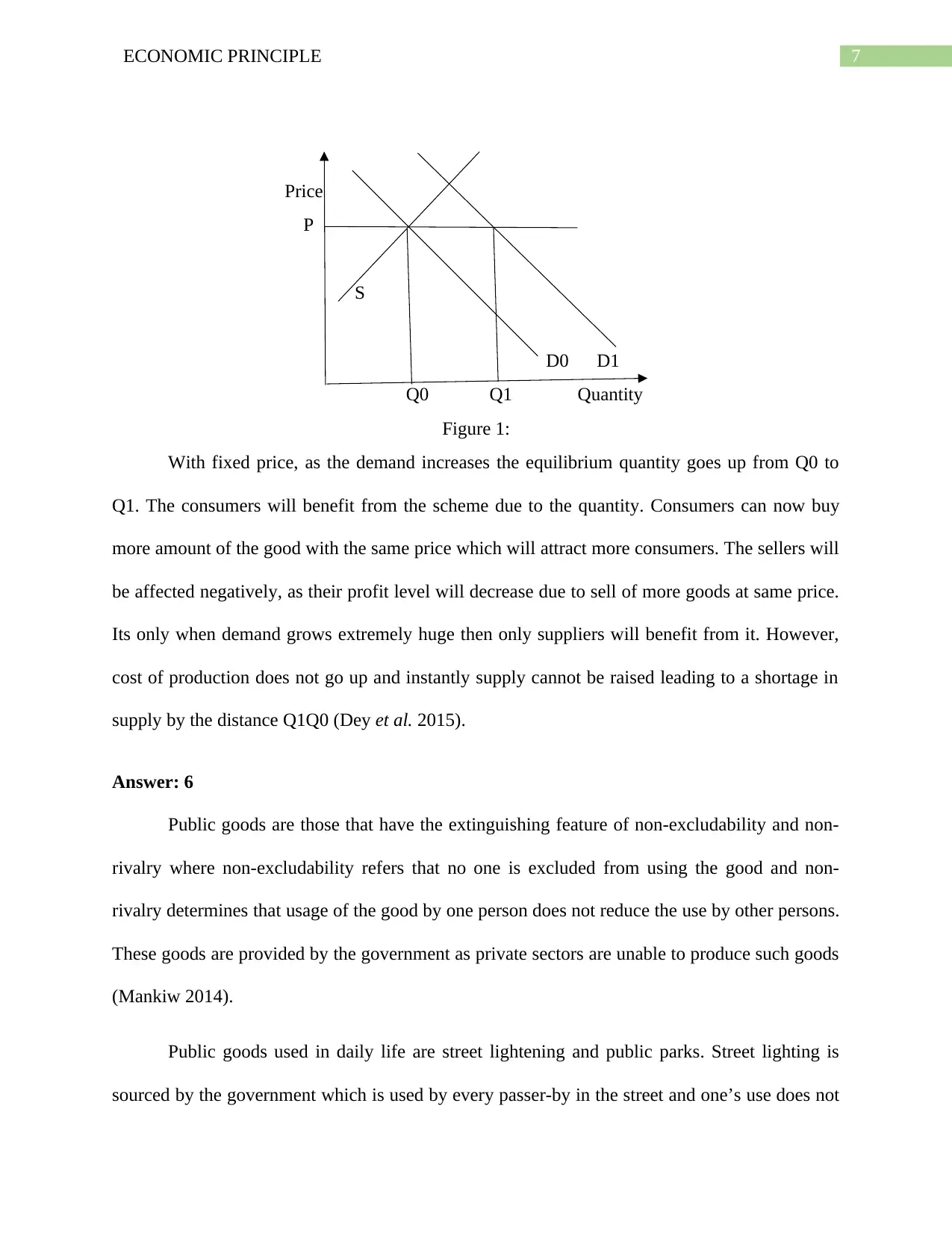
7ECONOMIC PRINCIPLE
Price
P
S
D0 D1
Q0 Q1 Quantity
Figure 1:
With fixed price, as the demand increases the equilibrium quantity goes up from Q0 to
Q1. The consumers will benefit from the scheme due to the quantity. Consumers can now buy
more amount of the good with the same price which will attract more consumers. The sellers will
be affected negatively, as their profit level will decrease due to sell of more goods at same price.
Its only when demand grows extremely huge then only suppliers will benefit from it. However,
cost of production does not go up and instantly supply cannot be raised leading to a shortage in
supply by the distance Q1Q0 (Dey et al. 2015).
Answer: 6
Public goods are those that have the extinguishing feature of non-excludability and non-
rivalry where non-excludability refers that no one is excluded from using the good and non-
rivalry determines that usage of the good by one person does not reduce the use by other persons.
These goods are provided by the government as private sectors are unable to produce such goods
(Mankiw 2014).
Public goods used in daily life are street lightening and public parks. Street lighting is
sourced by the government which is used by every passer-by in the street and one’s use does not
Price
P
S
D0 D1
Q0 Q1 Quantity
Figure 1:
With fixed price, as the demand increases the equilibrium quantity goes up from Q0 to
Q1. The consumers will benefit from the scheme due to the quantity. Consumers can now buy
more amount of the good with the same price which will attract more consumers. The sellers will
be affected negatively, as their profit level will decrease due to sell of more goods at same price.
Its only when demand grows extremely huge then only suppliers will benefit from it. However,
cost of production does not go up and instantly supply cannot be raised leading to a shortage in
supply by the distance Q1Q0 (Dey et al. 2015).
Answer: 6
Public goods are those that have the extinguishing feature of non-excludability and non-
rivalry where non-excludability refers that no one is excluded from using the good and non-
rivalry determines that usage of the good by one person does not reduce the use by other persons.
These goods are provided by the government as private sectors are unable to produce such goods
(Mankiw 2014).
Public goods used in daily life are street lightening and public parks. Street lighting is
sourced by the government which is used by every passer-by in the street and one’s use does not
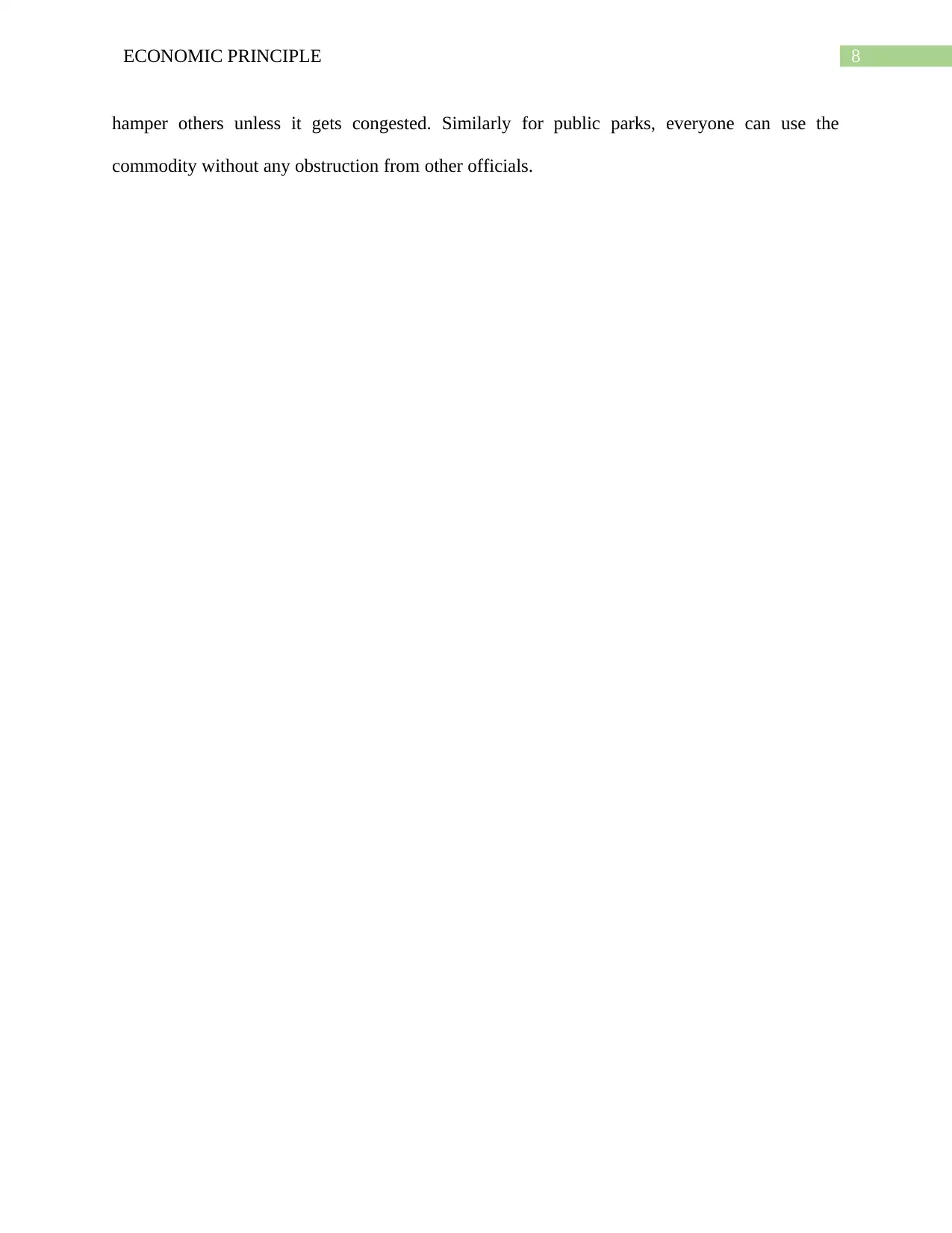
8ECONOMIC PRINCIPLE
hamper others unless it gets congested. Similarly for public parks, everyone can use the
commodity without any obstruction from other officials.
hamper others unless it gets congested. Similarly for public parks, everyone can use the
commodity without any obstruction from other officials.
⊘ This is a preview!⊘
Do you want full access?
Subscribe today to unlock all pages.

Trusted by 1+ million students worldwide
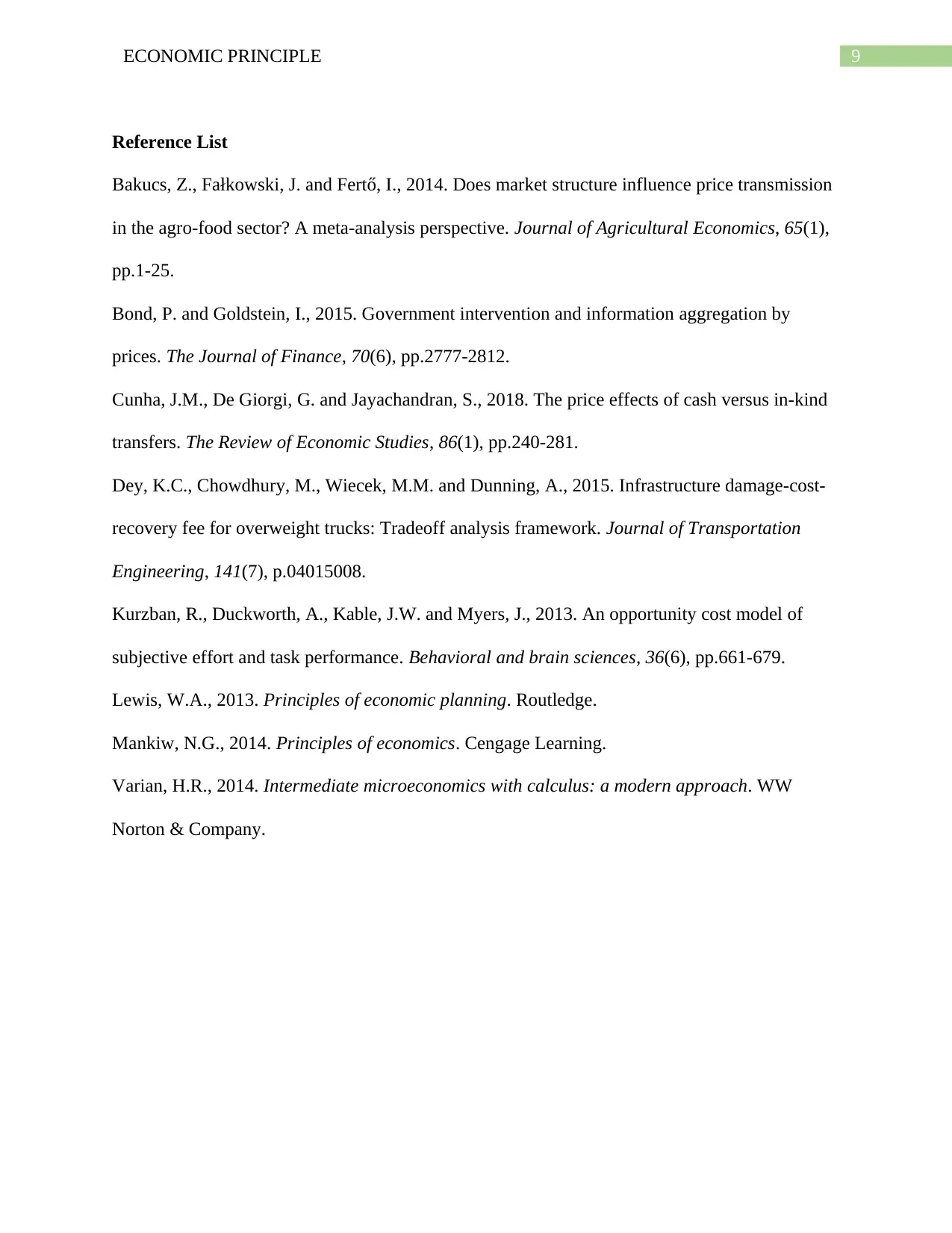
9ECONOMIC PRINCIPLE
Reference List
Bakucs, Z., Fałkowski, J. and Fertő, I., 2014. Does market structure influence price transmission
in the agro‐food sector? A meta‐analysis perspective. Journal of Agricultural Economics, 65(1),
pp.1-25.
Bond, P. and Goldstein, I., 2015. Government intervention and information aggregation by
prices. The Journal of Finance, 70(6), pp.2777-2812.
Cunha, J.M., De Giorgi, G. and Jayachandran, S., 2018. The price effects of cash versus in-kind
transfers. The Review of Economic Studies, 86(1), pp.240-281.
Dey, K.C., Chowdhury, M., Wiecek, M.M. and Dunning, A., 2015. Infrastructure damage-cost-
recovery fee for overweight trucks: Tradeoff analysis framework. Journal of Transportation
Engineering, 141(7), p.04015008.
Kurzban, R., Duckworth, A., Kable, J.W. and Myers, J., 2013. An opportunity cost model of
subjective effort and task performance. Behavioral and brain sciences, 36(6), pp.661-679.
Lewis, W.A., 2013. Principles of economic planning. Routledge.
Mankiw, N.G., 2014. Principles of economics. Cengage Learning.
Varian, H.R., 2014. Intermediate microeconomics with calculus: a modern approach. WW
Norton & Company.
Reference List
Bakucs, Z., Fałkowski, J. and Fertő, I., 2014. Does market structure influence price transmission
in the agro‐food sector? A meta‐analysis perspective. Journal of Agricultural Economics, 65(1),
pp.1-25.
Bond, P. and Goldstein, I., 2015. Government intervention and information aggregation by
prices. The Journal of Finance, 70(6), pp.2777-2812.
Cunha, J.M., De Giorgi, G. and Jayachandran, S., 2018. The price effects of cash versus in-kind
transfers. The Review of Economic Studies, 86(1), pp.240-281.
Dey, K.C., Chowdhury, M., Wiecek, M.M. and Dunning, A., 2015. Infrastructure damage-cost-
recovery fee for overweight trucks: Tradeoff analysis framework. Journal of Transportation
Engineering, 141(7), p.04015008.
Kurzban, R., Duckworth, A., Kable, J.W. and Myers, J., 2013. An opportunity cost model of
subjective effort and task performance. Behavioral and brain sciences, 36(6), pp.661-679.
Lewis, W.A., 2013. Principles of economic planning. Routledge.
Mankiw, N.G., 2014. Principles of economics. Cengage Learning.
Varian, H.R., 2014. Intermediate microeconomics with calculus: a modern approach. WW
Norton & Company.
1 out of 10
Related Documents
Your All-in-One AI-Powered Toolkit for Academic Success.
+13062052269
info@desklib.com
Available 24*7 on WhatsApp / Email
![[object Object]](/_next/static/media/star-bottom.7253800d.svg)
Unlock your academic potential
Copyright © 2020–2025 A2Z Services. All Rights Reserved. Developed and managed by ZUCOL.




